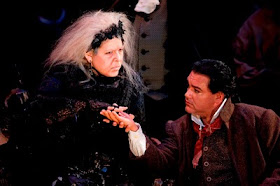 Elena Manistina (Ulrica) and Salvatore Licitra (Gustavus III) in Un Ballo in Maschera, Washington National Opera, 2010 (photo by Scott Suchman) Verdi, Un ballo in maschera (Google Books) |
True, Robinson does return the opera's story to Verdi's intended setting, the court of Sweden, rather than the Massachusetts Bay Colony, the apparently less threatening location imposed on him by censors worried about a regicide on stage in an era of actual revolution. Verdi's librettist, Antonio Somma, based the libretto on an earlier libretto by Eugène Scribe, for Daniel Auber's opera Gustave III. It tells the true story, slightly altered, of the King of Sweden, Gustav III, who was murdered at a masked ball in the foyer of the Royal Swedish Opera in Stockholm in 1792. The assassin, Jacob Johan Anckarström, was not actually the king's trusted friend but someone with a long-held grudge, and he did not stab the king but shot him in the back with a pistol. The king did not die immediately, as the opera tells it much more dramatically, but lingered until an infection killed him a couple weeks later. Anckarström was jailed and brutally executed not long afterward. The weirdest part of the story, that the murder had been foretold by a fortune-teller, is actually true, in at least that the king had received such a prophecy from Ulrica Arfvidsson, a medium (or very well informed society figure) in Stockholm, some years earlier.
Anne Midgette, WNO's 'Opera in the Outfield' event is a family-friendly day with Verdi (Washington Post, September 20) ---, Washington National Opera's 'Un Ballo in Maschera' (Washington Post, September 13) Kate Wingfield, Sound, but No Vision (Metro Weekly, September 18) Tim Smith, Washington National Opera opens season with generally effective 'Masked Ball' (Baltimore Sun, September 16) Terry Ponick, Verdi’s 'Masked Ball' opens D.C. opera's season (Washington Times, September 12) |
The set design by Allen Moyer spent most of the budget on a stage within a stage that broke into pieces to make scene transitions, transforming (more or less) into settings other than the king's audience hall. The 18th-century costumes (designed by James Schuette) emphasized the facelessness of the conspiracy with an overly gray uniformity, making the nobles almost into liveried servants. Guest conductor Daniele Callegari, making his company debut, led a suave performance by the Opera House Orchestra, not only with most of the kinks of the score worked out but also some fine individual playing, from the solo cello and low strings accompanying Amelia in Act III and from the offstage banda, ingeniously incorporated by Verdi into the ball music of the final scene. Ultimately, Ballo is a dramatic failure, no matter how strong the performance or staging, because the catastrophe -- the assassination -- happens to someone with whom we have very little sympathy until he is dying. Add to it that Amelia is not one of the distinctive Verdi heroines, and all that is left to admire is some gorgeous music. For the most part, that was the best part of this production.
This production will be repeated three more times, September 20, 22, and 25.
No comments:
Post a Comment